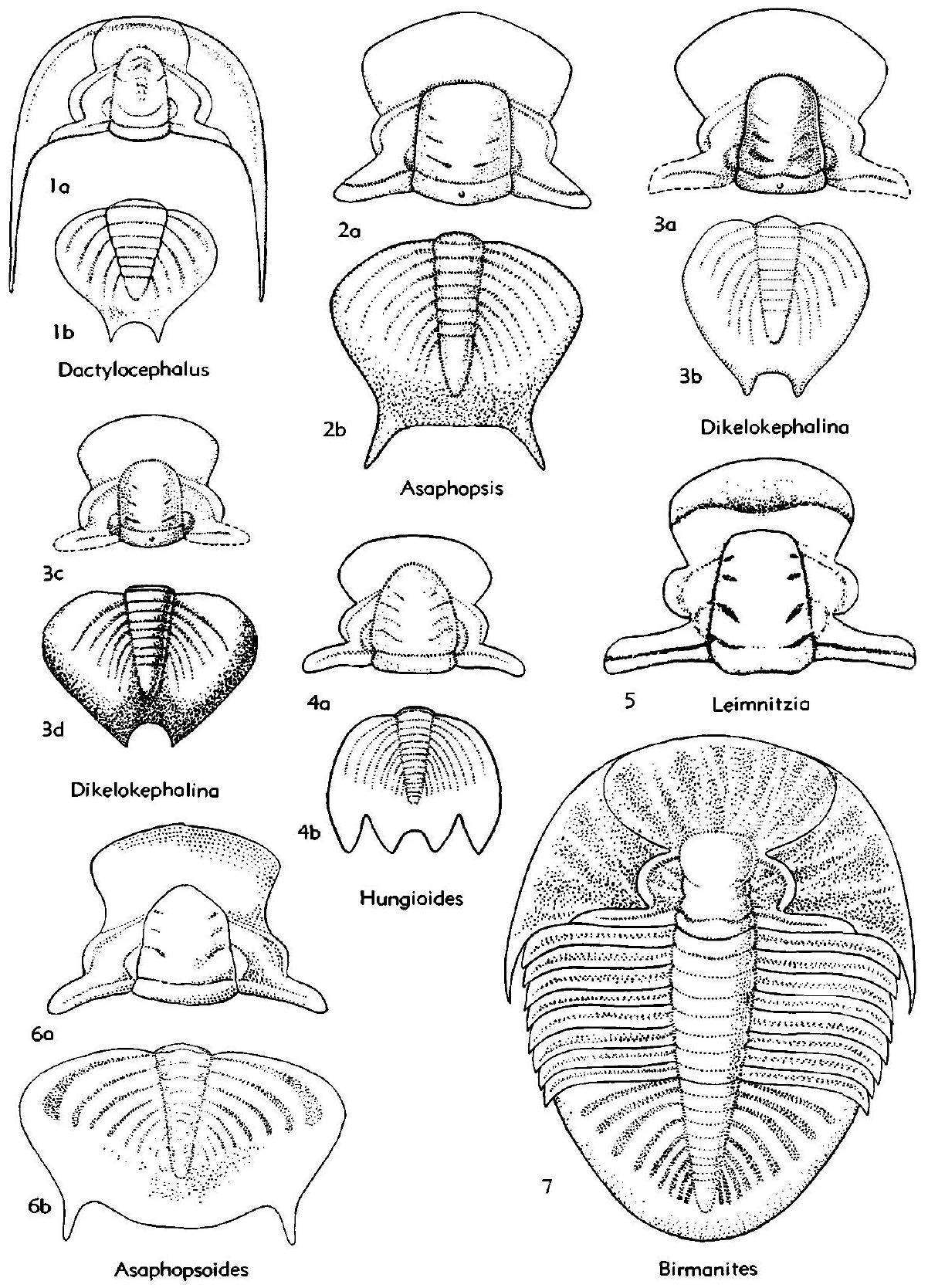Welcome to the Treatise on Invertebrate Paleontology!
Please enter a genera name to retrieve more information.

Birmanites
Classification
Phylum:
Arthropoda
Subphylum:
Trilobitomorpha
Class:
Trilobita
Order:
Ptychopariida
Suborder:
Asaphina
Family:
Dikelokephalinidae
Formal Genus Name and Reference:
Birmanites Sheng, 1934
Type Species:
Ogygites birmanicus REED, 1915
Images
(Click to enlarge in a new window)
Fig. 268, 7. *B. birmanicus (Reed), Tremadoc., Burma, exoskel. (reconstr.), x1 (419).
Synonyms
Geographic Distribution
E.Asia
Age Range
Beginning Stage in Treatise Usage:
L.Ord.
Beginning International Stage:
Tremadocian
Fraction Up In Beginning Stage:
0
Beginning Date:
486.85
Ending Stage in Treatise Usage:
L.Ord.
Ending International Stage:
Floian
Fraction Up In Ending Stage:
100
Ending Date:
471.26
Description
Glabella convex, urceolate tapering, with anterior pair of short oblique lateral furrows and 2 slitlike posterior pairs, frontal area almost 0.5 of length (sag.) of cranidium, eyes large, slightly posterior to center of glabella, fixigenae with palpebral areas 0.7 of glabellar width, posterior areas narrow (exsag.), same in length (tr.) as occipital ring, no alae observed, librigenae with short flat genal spines, thorax with 8 segments, pygidium subcircular, axis convex, narrow, tapered 0.83 of length to narrow pointed end, with 7 or 8 axial rings and terminal with 1 faint ring, pleural fields twice width of axis, merging into narrow border, with 7 or 8 pleurae separated by broad shallow interpleural grooves running to edge of border, posterior margin smoothly curved, caecal folds prominent on cephalon, known from the Lower Ordovician of East Asia
References
Museum or Author Information
Classification
Phylum:
Arthropoda
Subphylum:
Trilobitomorpha
Class:
Trilobita
Order:
Ptychopariida
Suborder:
Asaphina
Family:
Dikelokephalinidae
Formal Genus Name and Reference:
Birmanites Sheng, 1934
Type Species:
Ogygites birmanicus REED, 1915
Images
(Click to enlarge in a new window)
Fig. 268, 7. *B. birmanicus (Reed), Tremadoc., Burma, exoskel. (reconstr.), x1 (419).
Synonyms
Geographic Distribution
E.Asia
Age Range
Beginning Stage in Treatise Usage:
L.Ord.
Beginning International Stage:
Tremadocian
Fraction Up In Beginning Stage:
0
Beginning Date:
486.85
Ending Stage in Treatise Usage:
L.Ord.
Ending International Stage:
Floian
Fraction Up In Ending Stage:
100
Ending Date:
471.26
Description
Glabella convex, urceolate tapering, with anterior pair of short oblique lateral furrows and 2 slitlike posterior pairs, frontal area almost 0.5 of length (sag.) of cranidium, eyes large, slightly posterior to center of glabella, fixigenae with palpebral areas 0.7 of glabellar width, posterior areas narrow (exsag.), same in length (tr.) as occipital ring, no alae observed, librigenae with short flat genal spines, thorax with 8 segments, pygidium subcircular, axis convex, narrow, tapered 0.83 of length to narrow pointed end, with 7 or 8 axial rings and terminal with 1 faint ring, pleural fields twice width of axis, merging into narrow border, with 7 or 8 pleurae separated by broad shallow interpleural grooves running to edge of border, posterior margin smoothly curved, caecal folds prominent on cephalon, known from the Lower Ordovician of East Asia
